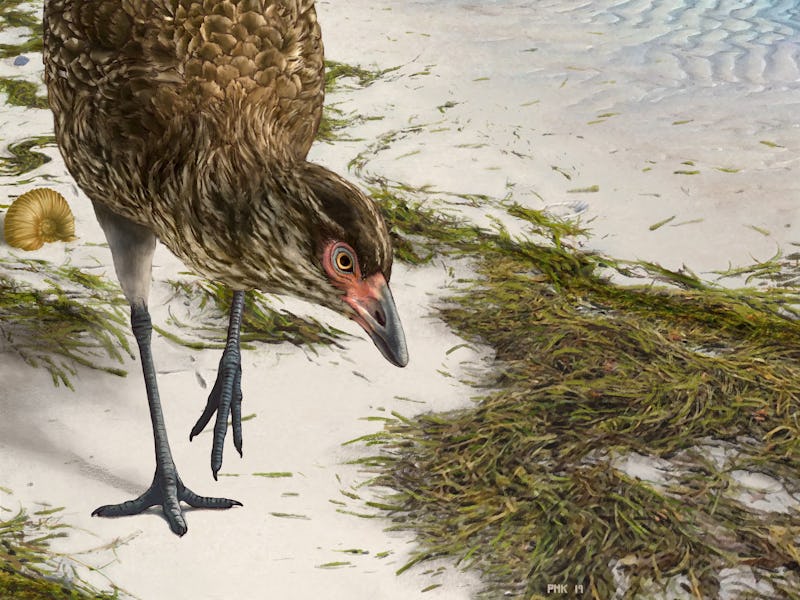Meet the ‘Wonderchicken,’ the oldest-ever bird fossil discovery
"We almost had to pinch ourselves when we saw it."

We aren't sure how it might have tasted, but a bird fossil paleontologists are dubbing the "Wonderchicken" has earned the distinction of being the earliest example of modern birds known to science.
The fossil find stems from a complete skull dating to less than a million years before an asteroid caused the mass extinction event at the end of the Cretaceous period, wiping out large dinosaurs completely.
Paleontologists detail the skull, and the bird it belonged to, in a new study published Wednesday in the journal Nature. Thanks to X-ray and CT scans, the researchers were able to identify the 66.7-million-year-old bird skull, which had lain hidden in limestone rock.
Amazingly, the Wonderchicken shares features with today’s chickens and ducks, hence its nickname.
The study offers new clues about how the Wonderchicken, Asteriornis maastrichtensis, survived the asteroid, while big dinos perished.
Researcher Daniel Field with a 3D printed model of the Wonderchicken skull.
The moment of discovery, which took place in a limestone quarry in Belgium, stands out to lead author Daniel Field, a researcher at the University of Cambridge.
"The moment I first saw what was beneath the rock was the most exciting moment of my scientific career," Field said in a statement.
"This is one of the best-preserved fossil bird skulls of any age, from anywhere in the world. We almost had to pinch ourselves when we saw it, knowing that it was from such an important time in Earth's history.”
Bones tell story of the past
In addition to the full skull, the ancient fossil contains a few small fragments of leg bones. Together, the bones suggest the Wonderchicken's features resemble the bird group Galloanserae, which includes modern-day chickens and ducks.
The Wonderchicken was probably a “mash-up” of the two, Field said.
Modern chicken-like birds. Clockwise from upper left: Australian Brush turkey, Chestnut-bellied Guan, Cape Francolin, Gambel’s Quail.
The researchers say that the old bones tell a new story about what life was like before the asteroid that changed everything. And it gives new clues to the evolution of birds at that crucial time.
"This fossil tells us that early on, at least some modern birds were fairly small-bodied, ground-dwelling birds that lived near the seashore," Field said.
The skull's location is also telling. Fossils from the late Cretaceous period are hard to come by in Europe, the researchers say, so pinning this bird species to Europe during this timeframe is illuminating.
That bodes well for future research, Field said.
"Asteriornis now gives us a search image for future fossil discoveries,” he said.
"Hopefully it ushers in a new era of fossil finds that help clarify how, when and where modern birds first evolved."
Abstract: Our understanding of the earliest stages of crown bird evolution is hindered by an exceedingly sparse Mesozoic fossil record. The most ancient phylogenetic divergences among crown birds are known to have occurred in the Cretaceous, but stem lineage representatives of the deepest crown bird subclades—Palaeognathae (ostriches and kin), Galloanserae (landfowl and waterfowl), and Neoaves (all other extant birds)—are entirely unknown from the Mesozoic. As a result, key questions related to ancestral crown bird ecology, biogeography, and divergence times remain unanswered. Here, we report a new Mesozoic fossil that occupies a position close to the last common ancestor of Galloanserae, filling a key phylogenetic gap early in crown bird evolutionary history. Asteriornis maastrichtensis, gen. et sp. nov., from the Maastrichtian of Belgium, is represented by a nearly complete, three-dimensionally preserved skull and associated postcranial elements. The fossil represents one of the only well-supported crown birds from the Mesozoic Era, and is the first Mesozoic crown bird with well represented cranial remains. A. maastrichtensis exhibits a heretofore undocumented combination of galliform (landfowl)-like and anseriform (waterfowl)-like features, and, along with a previously reported Ichthyornis-like taxon from the same locality, provides the first direct evidence of co-occurring crown birds and avialan stem birds. Its occurrence in the northern hemisphere challenges biogeographic hypotheses of a Gondwanan origin of crown birds, and its relatively small size and possible littoral ecology may corroborate recently proposed ecological filters, influencing crown bird persistence through the end-Cretaceous mass extinction.